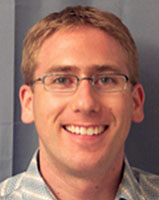
Handy Links
SLAC News Center
SLAC Today
- Subscribe
- Archives: Feb 2006-May 20, 2011
- Archives: May 23, 2011 and later
- Submit Feedback or Story Ideas
- About SLAC Today
SLAC News
Lab News
- Interactions
- Lightsources.org
- ILC NewsLine
- Int'l Science Grid This Week
- Fermilab Today
- Berkeley Lab News
- @brookhaven TODAY
- DOE Pulse
- CERN Courier
- DESY inForm
- US / LHC
SLAC Links
- Emergency
- Safety
- Policy Repository
- Site Entry Form

- Site Maps
- M & O Review
- Computing Status & Calendar
- SLAC Colloquium
- SLACspeak
- SLACspace
- SLAC Logo
- Café Menu
- Flea Market
- Web E-mail
- Marguerite Shuttle
- Discount Commuter Passes
-
Award Reporting Form
- SPIRES
- SciDoc
- Activity Groups
- Library
Stanford
Around the Bay
Mike Bogan

A physicist, a chemist and a microbiologist walk into a bar… or better yet, a conference on X-ray imaging. It's not the set-up for a joke, but a good opportunity for Mike Bogan to interface with potential users of the Linac Coherent Light Source. While he develops instruments to analyze a wide range of materials in the LCLS X-ray beam, Bogan is actively spreading the word about the light source's capabilities and its benefits for scientists in different disciplines.
"We want to take advantage of LCLS and get the best and brightest people to use it," Bogan says.
Straightforward and easy to talk to, Bogan dives into a description of his work as a staff scientist with the Photon Ultrafast Laser Science and Engineering center, or PULSE. Along with performing his own biophysics research, he develops instruments that will allow all samples, including cells, viruses, nanoparticles, nanocrystals and single biomolecules, to be analyzed with high efficiency by LCLS.
Bogan's own background is also an interface between different branches of science. He earned his PhD in chemistry at Simon Fraser University, where he worked on a collaborative project on membrane protein structure. He completed his postdoctoral work at Lawrence Livermore National Laboratory and worked there as a biophysicist doing research with Matthias Frank on single particle aerosol mass spectrometry of polymers and biological materials. While working at LLNL he was also part of the team, lead by Henry Chapman and Janos Hajdu, that performed the first successful single pulse X-ray diffractive imaging experiments using the free electron laser in Hamburg (called FLASH). The group used the laser to demonstrate that nanoscale structures can be imaged before they are destroyed by the ultrafast and ultrabright X-ray pulses. The LCLS will be the next step in free electron lasers, eventually providing higher resolution images than are possible with FLASH.
At a recent PULSE seminar, Bogan delivered a talk to PULSE and SSRL staff titled "Bringing the Bio- to LCLS," in which he reviewed the current challenges and opportunities associated with performing bioscience experiments with LCLS. He reviewed several techniques currently in development that will enable scientists to analyze their biological or inorganic samples of choice with LCLS. Bogan says the talk delivered "the missing piece of the puzzle for a lot of biologists who hear about LCLS and think 'How do I even get my proteins/cells/viruses into the beam?' " His talk showed that proof-of-concept experiments at FLASH have answered this question, and other groups are working to improve efficiency in this area or find ways to perform specific types of experiments. "Often the response I get is a sense of relief that someone is working on this," he says. "Or a sense of renewed motivation because the experiments now seem more realistic to them after seeing the FLASH results."
Before he found his calling in science, Bogan says he was a "good Canadian kid" and dreamt of being a professional hockey player. "Hockey is so huge [in Canada]," he recalls. "I played almost everyday from the time I was four or five until I went to university." Bogan no longer frequents the hockey rinks; instead, he and his wife are active cyclists. They take regular camping trips that include day-long bike rides in the Sierra Nevadas and Yosemite national park. Living in the San Francisco area, they also enjoy riding along the bay with so many other cyclists. Bogan says he is also invigorated by the Bay Area's huge scientific community.
Bogan and his fellow scientists have plenty of work to do before the LCLS starts taking users in early 2009. At SLAC, he and the other collaborators must perfect methods for delivering biomaterials and other samples into the LCLS beam. Meanwhile, Bogan continues to visit various conferences to discuss the LCLS with scientists who are unfamiliar with its capabilities.
—Calla Cofield
SLAC Today, September 10, 2008